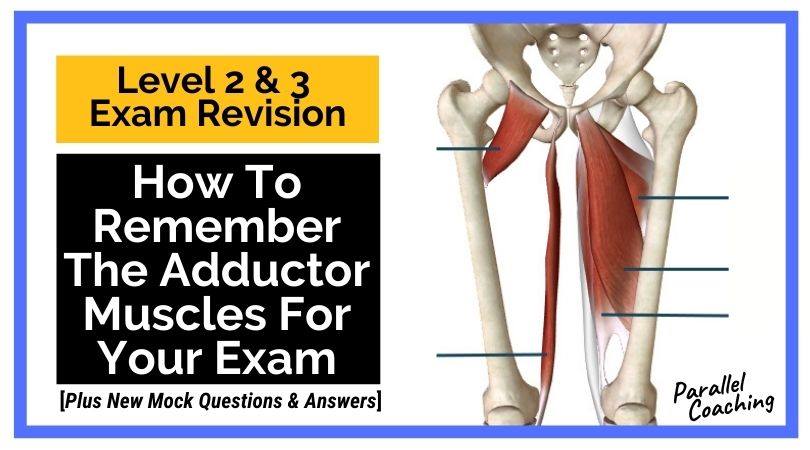In today’s blog, you’ll learn how to remember the Adductor muscles and their origins and insertions
You’ll discover:
- Where are the Adductor Muscles?
- Which 5 muscles make up the Adductor group?
- What do I need to know about Adductor for the exam?
- How to Remember the Adductor Muscles
- The origins and insertions of the Adductor Muscles
- Test your knowledge with 3 Mock Questions and answers
- How to learn and remember the muscles for your exam
Before I share a super-easy way to remember the Adductors, let’s first understand where they are located and what the Adductor muscles are called?
Where are the Adductor Muscles?
The Adductor group is located on the inside of the thigh,
All Five muscles originate on the lower pelvic bones at either the ischium (sits bones) and or pubis (pubic bone)
and then cross the hip, before inserting at various points along the medial edge of the Femur. However, the Gracilis crosses both the knee and hip, inserting on the upper tibia.
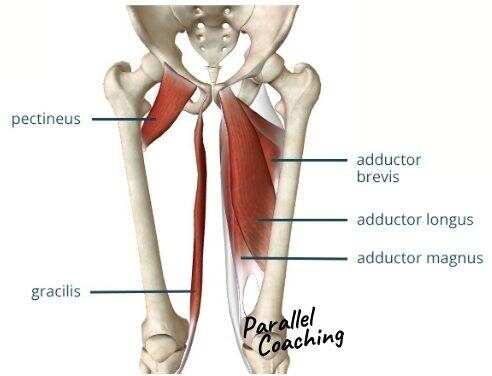
Which 5 muscles make up the Adductor group?
The Adductor Group is made up of Five muscles:
- Adductor Magnus
- Adductor Longus
- Adductor Brevis
- Pectineus
- Gracilis
What do I need to know about Adductors for the L3 Anatomy exam?
You need to know a few key characteristics of the Adductor Group in preparation for your Level 3 Anatomy and Physiology Exam
- the name of all 5 in the group
- their locations
- the origins and insertions
- joint actions and what exercises target the muscles
How to Remember the Five Adductor Muscles?
It is important to find a unique way to remember the muscles, as it will help it stand out when you are trying to retrieve it from your memory later…
To help you remeber the Adductor Muscles and some key characteristics, consider the Adductor group as the Adductor Kingdom:
The Adductor Magnus is the King – Large, strong and dominant in the actions, “King Magnus” has a real ring to it!
The Adductor Longus is the Queen – Long, elegant, and plays a large part of the action, the kingdom wouldn’t work without her.
The Adductor Brevis is the Prince – Small and specific role, but still greater than that of the princess. The word Brevis eludes to being Brief (small).
The Pectineus is the Princess – Tiny and has a small and specific role.
The Gracilis is the Jester – Looks out of place as it is the only one that crosses the knee.
TOP TIP : Exam questions like to check that you know the Pectineus and the Gracilis are part of the Adductor group.
The Origins and Insertions of the Adductor Muscles
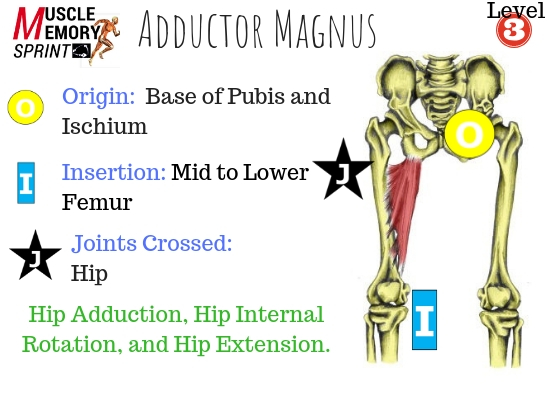
The Adductor Magnus
- Origin: Base of Pubis and Ischium
- Insertion: Mid to Lower Femur
- Joint: Hip
- Joint Action (concentric phase): Hip Adduction, Hip Internal Rotation, and Hip Extension
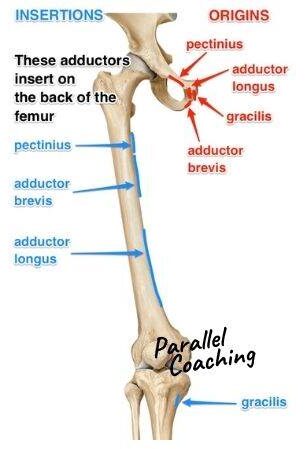
The Adductor Longus
- Origin: Anterior Pubis
- Insertion: Mid Femur
- Joint: Hip
- Joint Action (concentric phase): Hip Adduction, and Hip Internal Rotation
The Adductor Brevis
- Origin: Anterior Pubis
- Insertion: Upper Femur
- Joint: Hip
- Joint Action (concentric phase): Hip Adduction, and Hip Internal Rotation
The Pectineus
- Origin: Anterior Superior Pubis
- Insertion: Posterior Upper Femur
- Joint: Hip
- Joint Action (concentric phase): Hip Adduction, and Hip Flexion
The Gracilis
- Origin: Anterior Inferior Pubis
- Insertion: Medial Upper Tibia
- Joint: Hip and Knee
- Joint Action (concentric phase): Adduction and Internal Rotation of the Hip and Knee Flexion
Joint Actions of the Adductor Group
The Primary Joint action ( in the concentric phase) of the Adductor Group is Hip Adduction and Hip Internal Rotation.
However, due to the different attachment points, some of the muscles also contribute towards Hip Extension, Hip Flexion and even Knee Flexion
Example Exercises that target the Adductors include:
Hip Adductor Machine, Bringing the leg into the midline, Pilates Inner Thigh Squeeze, Squats, Walking Lunges, and Pronation of the foot specifically during internal rotation of the femur.
Looking for Tight Adductors
Adductors has a propensity to be shorter and tighter than some other muscles in the body. This means you will commonly see tight adductor muscles in your clients, especially if they have tight hamstrings.
A clue that the Adductors are tight, is that during a squat, the clients knees look like they are being pulled towards the mid-line ( when viewed from the front).
This is evident if they do a squat and their knees are not tracking in line with the second toe, but fall inwards slightly.
When the Adductors are tight they create internal rotation of the femur, and adduction of the hip. These two actions combined whilst squatting, are what makes the knee appear to be moving towards the midline.
A good way to rectify this is to stretch the adductors and work on external rotation of the hip, and supination of the foot during squatting.
You take your body into the exam
It sounds silly, doesn’t it? Of course, you take your body into the exam
However, consider that touching the body parts that are asked in the exam questions allows your brain to connect a kinaesthetic understanding and helps you bring back key parts of your revision
To the front, your mind and tip of your pen to score the correct answer.
Therefore, you take the best anatomical guide into your fitness exam that gives you all the answers you’ll ever need.
It means you can use your body on exam day, to remember the Adductor Muscles… and all the rest of the muscles too.
Slow down in the exam.
You have plenty of time to think about the questions and the possible 4 answers and locate what the exam is asking of you on your body.
there are 26 muscles at level 2 A&P and 50 at level 3 A&P… muscles is usually the module that most learners struggle with?
which is why we have created the Level 2 and Level 3 Muscle Memory Flashcards. All the muscles are clearly outlined on done-for-you flashcards so you can just focus on revising and not making your own.
Yes – let me see the L2 Flashcards or L3 Flashcards
Test your knowledge with 3 Mock Questions
Look at the 3 Mock Anatomy and Physiology Test questions below and jot down your answer on a scrap paper or as a note on your phone.
Then scroll down to reveal the answers.
1) Which of the following does NOT create Hip Adduction during a concentric contraction?
A. Pectineus
B. Tensor Fascia Latae
C. Gracilis
D. Adductor Longus
2) What is the Origin of the Adductor Magnus
A. Ilium and Pubis
B. Ischium and Pubis
C. Tibia
D. Femur
3) What is the Insertion of the Pectineus
A. Posterior Upper Femur
B. Anterior Mid Femur
C. Pubis
D. Upper Tibia
Answers:
Q1: Answer = B
Q2: Answer = B
Q3: Answer = A
If you want more mock questions like this, then you can download more Free Mock Questions: DOWNLOAD NOW
How to learn origins and insertions?
Learn, Revise & Remember All 50 Muscles In The Level 3 Anatomy & Physiology Exam.
(and the BEST part…You can do all this in as little as 5-minutes a day)
Each flashcard gives you a clear image and six clear muscle facts:
- Name and Location
- Origin and Insertions
- Muscle Actions
- Joints Crossed
- Primary Planes Of Movement
- Exercise Examples
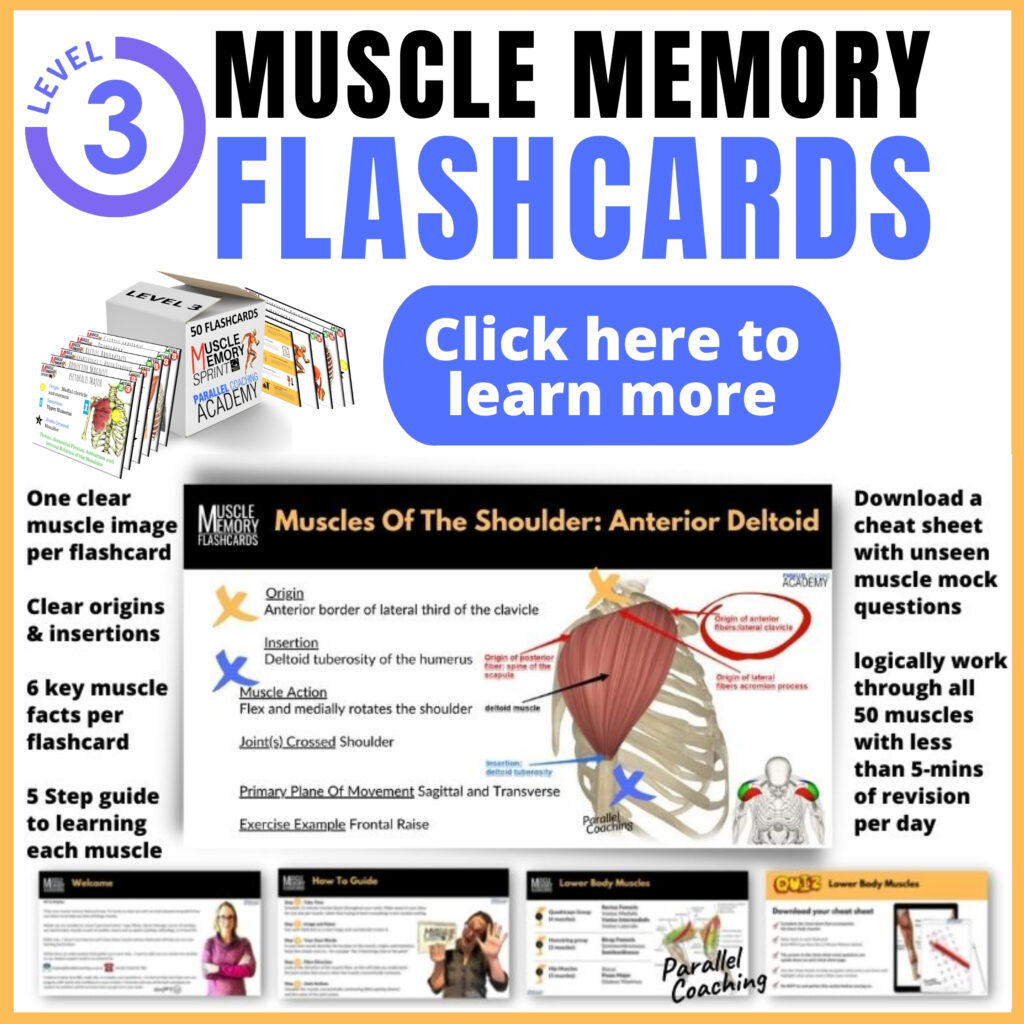
Dedicated to More
Hayley “Remember the Adductor Muscles” Bergman
Parallel Coaching
P.S. You can also find us on the following platforms:
Instagram: Follow Now
Facebook: Like Our Page
Twitter: Tweet Us
YouTube: Subscribe Here
More Muscle Revision Blogs: HERE

